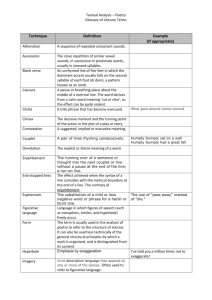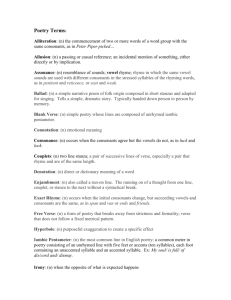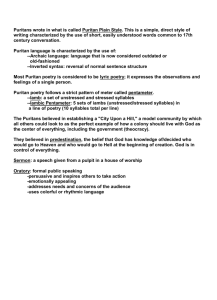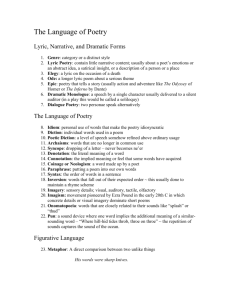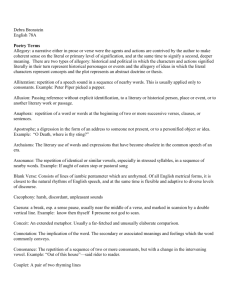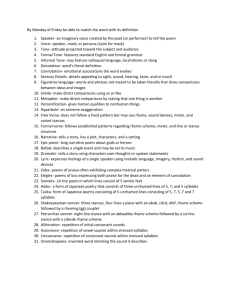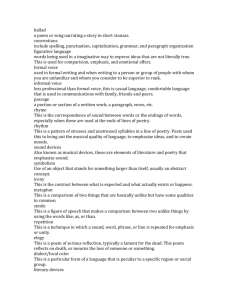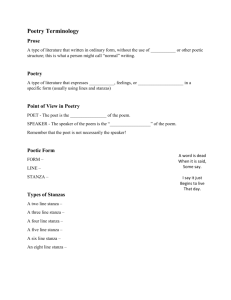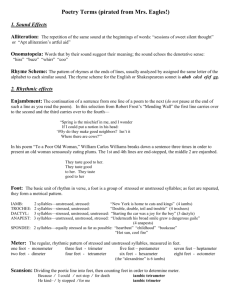Literary Terms: Poetry Terms
advertisement
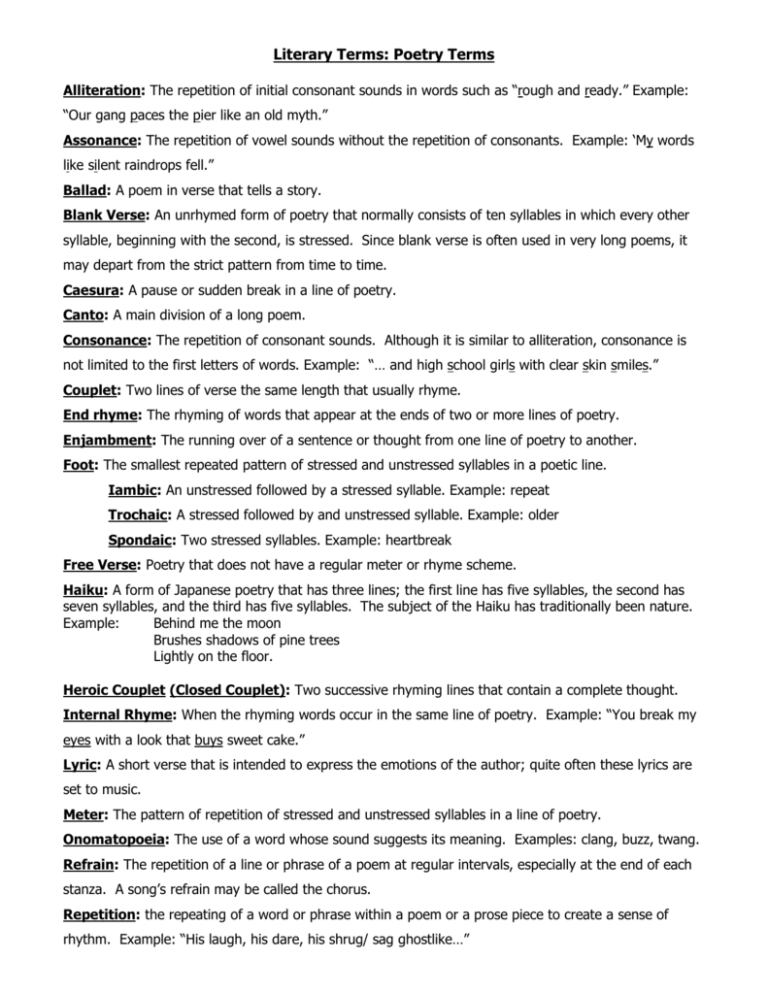
Literary Terms: Poetry Terms Alliteration: The repetition of initial consonant sounds in words such as “rough and ready.” Example: “Our gang paces the pier like an old myth.” Assonance: The repetition of vowel sounds without the repetition of consonants. Example: ‘My words like silent raindrops fell.” Ballad: A poem in verse that tells a story. Blank Verse: An unrhymed form of poetry that normally consists of ten syllables in which every other syllable, beginning with the second, is stressed. Since blank verse is often used in very long poems, it may depart from the strict pattern from time to time. Caesura: A pause or sudden break in a line of poetry. Canto: A main division of a long poem. Consonance: The repetition of consonant sounds. Although it is similar to alliteration, consonance is not limited to the first letters of words. Example: “… and high school girls with clear skin smiles.” Couplet: Two lines of verse the same length that usually rhyme. End rhyme: The rhyming of words that appear at the ends of two or more lines of poetry. Enjambment: The running over of a sentence or thought from one line of poetry to another. Foot: The smallest repeated pattern of stressed and unstressed syllables in a poetic line. Iambic: An unstressed followed by a stressed syllable. Example: repeat Trochaic: A stressed followed by and unstressed syllable. Example: older Spondaic: Two stressed syllables. Example: heartbreak Free Verse: Poetry that does not have a regular meter or rhyme scheme. Haiku: A form of Japanese poetry that has three lines; the first line has five syllables, the second has seven syllables, and the third has five syllables. The subject of the Haiku has traditionally been nature. Example: Behind me the moon Brushes shadows of pine trees Lightly on the floor. Heroic Couplet (Closed Couplet): Two successive rhyming lines that contain a complete thought. Internal Rhyme: When the rhyming words occur in the same line of poetry. Example: “You break my eyes with a look that buys sweet cake.” Lyric: A short verse that is intended to express the emotions of the author; quite often these lyrics are set to music. Meter: The pattern of repetition of stressed and unstressed syllables in a line of poetry. Onomatopoeia: The use of a word whose sound suggests its meaning. Examples: clang, buzz, twang. Refrain: The repetition of a line or phrase of a poem at regular intervals, especially at the end of each stanza. A song’s refrain may be called the chorus. Repetition: the repeating of a word or phrase within a poem or a prose piece to create a sense of rhythm. Example: “His laugh, his dare, his shrug/ sag ghostlike…” Rhyme: The similarity or likeness of sound existing between two words. Example: “sat” and “cat” are perfect rhymes because the vowel and final consonant sounds are exactly the same. Rhymed Verse: Verse with end rhyme that usually has regular meter. Rhythm: The ordered, or free occurrences of sound in poetry. Ordered or regular rhythm is called meter. Free occurrence of sound is called free verse. Sonnet: A poem consisting of fourteen lines of iambic pentameter. There are two popular forms of sonnets: 1. Italian (Petrarchan) Sonnet: Has two parts; an octave (eight lines) and a sestet (six lines) usually rhyming abbaabba, cdecde. Often a question is raised in the octave that is answered in the sestet. 2. Shakespearean (English or Elizabethan) Sonnet: Consists of three quatrains (four lines) and a final rhyming couplet (two lines). The rhyme scheme is abab, cdcd, efef, gg. Usually the question or theme is set forth in the quatrains while the answer or resolution appears in the final couplet. Stanza: A division of poetry named for the number of lines it contains. 1.Couplet: two line stanza 2. Triplet: three line stanza 3. Quatrain: four line stanza 4. Quintet: five line stanza 5. Sestet: six line stanza 6. Septet: seven line stanza 7. Octave: eight line stanza Verse: A metric line of poetry. It is named according to the kind and number of feet composing it. Example: Iambic (an unstressed followed by a stressed syllable) Pentameter (five feet). 1.Monometer: one foot 5. Pentameter: five feet 2. Dimeter: two feet 3. Trimeter: three feet 4. Tetrameter: four feet 6. Hexameter: six feet 7.Heptameter: seven feet 8. Octometer: eight feet Personification: A literary device in which the author speaks of or describes an animal, object, or idea, as if it were a person. Example: “The rock stubbornly refused to move!” Simile: A comparison of two unlike things in which a word of comparison (like or as) is used. Example: “She stood in front of the altar, shaking like a freshly caught trought.” Metaphor: A comparison of two unlike things in which no word of comparison (like or as) is used. Example: “ A green plant is a machine that runs on solar energy.” Antithesis: An opposition, or contrast, of ideas. Example: “It was the best of times, it was the worst of times…” Hyperbole: An exaggeration or overstatement. Example: “I have seen this river so wide it only had one bank. Imagery: The words or phrases a writer selects to create a certain picture in the reader’s mind. Imagery is usually based on sensory details. Example: “The sky was dark and gloomy, the air was damp and raw, the streets were wet and sloppy.” Symbol: A person, a place, a thing, or an event used to represent something else. Example: A dove is a symbol of peace.

